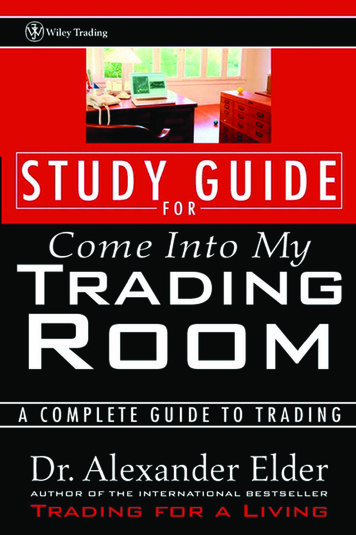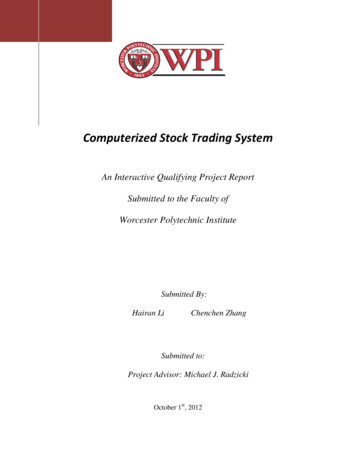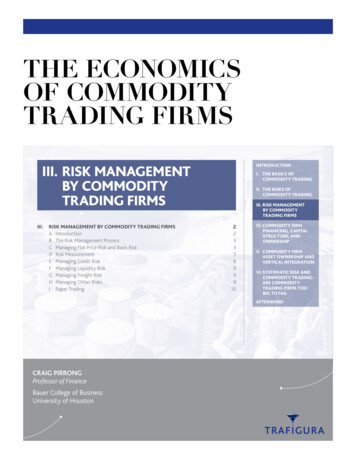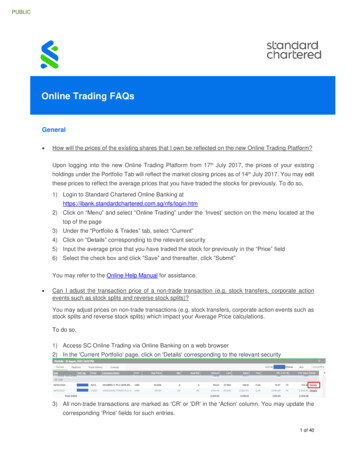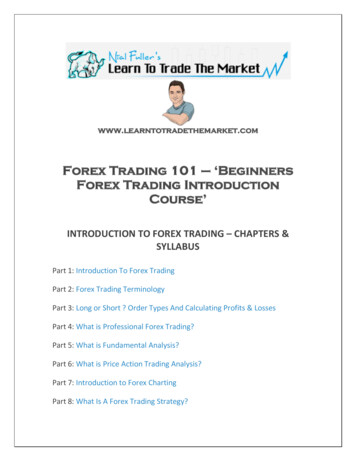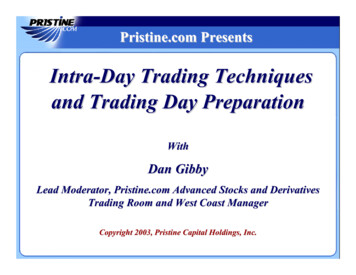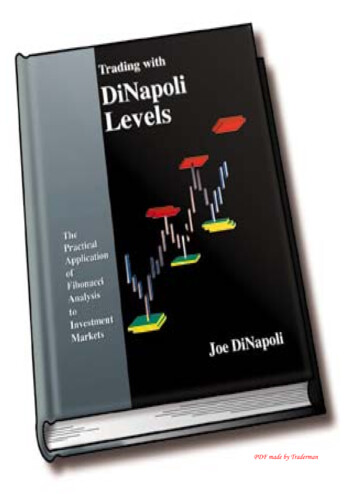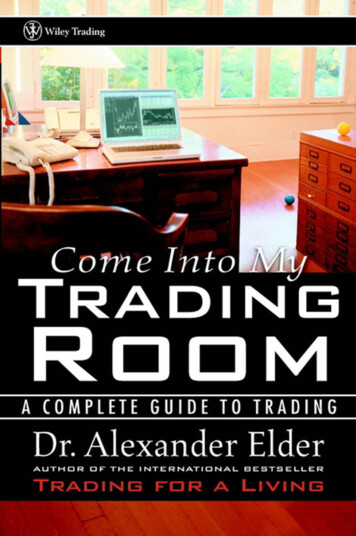
Transcription
COME INTO MY TRADING ROOMA Complete Guide to TradingDr. Alexander Elderwww.elder.comJohn Wiley & Sons, Inc.New York Chichester Weinheim Brisbane Singapore Toronto
COME INTO MY TRADING ROOMA Complete Guide to Trading
BOOKSBYDR. ALEXANDER ELDERTrading for a LivingStudy Guide for Trading for a LivingRubles to Dollars:Making Money on Russia’s Exploding Financial Frontier
COME INTO MY TRADING ROOMA Complete Guide to TradingDr. Alexander Elderwww.elder.comJohn Wiley & Sons, Inc.New York Chichester Weinheim Brisbane Singapore Toronto
To my campersCopyright 2002 by Dr. Alexander Elder. All rights reserved.Published by John Wiley & Sons, Inc.No part of this publication may be reproduced, stored in a retrieval system or transmitted in any form or by any means, electronic, mechanical, photocopying, recording,scanning or otherwise, except as permitted under Sections 107 or 108 of the 1976United States Copyright Act, without either the prior written permission of the Publisher, or authorization through payment of the appropriate per-copy fee to theCopyright Clearance Center, 222 Rosewood Drive, Danvers, MA 01923, (978) 750-8400,fax (978) 750-4744. Requests to the Publisher for permission should be addressed tothe Permissions Department, John Wiley & Sons, Inc., 605 Third Avenue, New York,NY 10158-0012, (212) 850-6011, fax (212) 850-6008, E-Mail: PERMREQ@WILEY.COM.This publication is designed to provide accurate and authoritative information in regardto the subject matter covered. It is sold with the understanding that the publisher is notengaged in rendering professional services. If professional advice or other expert assistance is required, the services of a competent professional person should be sought.This title is also available in print as ISBN 0-471-22534-7. Some content that appears inthe print version of this book may not be available in this electronic edition.For more information about Wiley products, visit our web site at www.Wiley.com.
CONTENTSDedicationivIntroduction1HOW THIS BOOK IS ORGANIZEDMALE OR FEMALE?PART ONE FINANCIAL TRADING FOR BABES IN1 Invest? Trade? Gamble?AN INTELLIGENT INVESTORAN INTELLIGENT TRADERAN INTELLIGENT GAMBLER?2 What Markets to Trade?STOCKSFUTURESOPTIONS3 The First StepsTHE EXTERNAL BARRIERS TO SUCCESSGETTING YOUR GEARANALYSIS AND TRADING24THEWOODSPART TWO THE THREE M’S OF SUCCESSFUL TRADING4 Mind—The Disciplined TraderSLEEPWALKING THROUGH THE MARKETA REMEDY FOR SELF-DESTRUCTIVENESSTHE MATURE TRADER5 Method—Technical AnalysisBASIC CHARTINGINDICATORS—FIVE BULLETS TO A CLIP57781215161820252532394547495461676884v
viTABLE OF CONTENTS6 TradingSYSTEM TESTINGTRIPLE SCREEN UPDATEDAY-TRADINGTHE IMPULSE SYSTEMMARKET THERMOMETEREXITING TRADESCHOOSING WHAT TO TRADE7 Money Management FormulasNO MATH ILLITERATESBUSINESSMAN’S RISK VS. LOSS.THE 2% SOLUTION—PROTECTION FROM SHARKSTHE 6% RULE—PROTECTION FROM PIRANHASPOSITION SIZINGMONEY MANAGEMENT PART THREE COME INTO MY TRADING ROOM8 The Organized TraderTRADER’S SPREADSHEETTHE EQUITY CURVETRADING DIARYACTION PLAN9 Trading for a LivingDISCIPLINE AND HUMILITYHAVE YOU GOT THE TIME?THE DECISION-MAKING TREEBEGINNER, SEMIPRO, PROGOING PRO10 Come Into My Trading RoomEXCERPTS FROM THE DIARYYOUR NEXT Acknowledgments301Sources303Index307About the Author313
INTRODUCTION“You can be free. You can live and work anywhere in the world,be independent from the routine and not answer to anybody.”With those words I began my first book, Trading for a Living. One ofmy great pleasures in the years since its publication has been meetingand becoming friends with people who became free thanks to successful trading.Several times a year I run a Traders’ Camp, a week of intensiveclasses at remote resorts. I enjoy my campers’ successes. A stockbrokerbecame a full-time trader, closed his business, and moved to Rio topursue a life-long interest in Latin women. A psychologist becamesuch a successful options writer that she paid for an early retirementfor her husband and moved with him to the Virgin Islands to becomean expert in what she calls synchronous hammocking. A man boughta mountain in Vermont and trades from the house he built on its top.I wish all students could succeed, but it’s not that simple.How many psychiatrists does it take to change a lightbulb? Onlyone—but the bulb has to want to change.To succeed in trading you need several innate traits without whichyou shouldn’t even start. They include discipline, risk tolerance, andfacility with numbers. A big fat guy who is often drunk and can’t kicka cigarette habit is unlikely to make a good trader—he lacks discipline.A nitpicker who obsesses over each dime is too tense to live with market risks. A daydreamer who cannot do simple arithmetic on the runbecomes lost when prices change rapidly.In addition to discipline, risk tolerance, and ease with numbers, successful trading requires 3 M’s—Mind, Method, and Money. Mind meansdeveloping psychological rules that will keep you calm amidst the1
2INTRODUCTIONnoise of the markets. Method is a system of analyzing prices anddeveloping a decision-making tree. Money refers to money management, which means risking only a small part of your trading capital onany trade; think of the way a submarine is divided into many compartments so that it won’t sink if one section becomes flooded—youhave to structure your account this way. Psychology, trading tactics,money management—you can learn these skills.How long will it take you to become a competent trader and howmuch will it cost? What rules do you set, what methods do you use,and how do you split your trading capital? What should you study first,second, and third? What markets should you trade, and how muchmoney can you expect to make? If these questions interest you, youpicked the right book.You can succeed in trading. It has been done before, and it’s beingdone right now, today, by people who started from scratch, learned totrade and are making a good living at it. The best ones make fortunes.Others fail, out of ignorance or lack of discipline. If you work throughthis book, ignorance will not be a problem, and you will hear me yellat you again and again, pointing you towards disciplined, responsible,professional trading.Trading is a journey of self-discovery. If you enjoy learning, if youare not scared of risk, if the rewards appeal to you, if you are preparedto put in the work, you have a great project ahead of you. You willwork hard and enjoy the discoveries you’ll make along the way.I wish you success. Now let us begin.HOW THIS BOOK IS ORGANIZEDBooks written from the heart acquire their own direction. They developand change in the process of being written. You start with a plan, butthe book takes over, and before you know it, you’re going much farther than planned.I began writing this book three years ago on a flight to New York,returning from a Traders’ Camp in Mexico. We had more beginnersthan usual, many of them women. They kept asking for a book thatthey jokingly called Trading for Dummies. There were no dummies inour group. Those campers were smart, sharp, and motivated—but theyneeded to learn the rules and the tools. I figured I would write a brief
INTRODUCTION3practical introduction, call it Financial Trading for Babes in the Woods,and be done by Christmas.Three Christmases passed before I completed my project. The beginnerpart was easy, but I kept tunneling into the depths of trading, sharingwhat I learned in the nine years since Trading for a Living was published. I developed new indicators and systems. My money managementbecame crisper, and I designed a new approach to record keeping. Mywork with hundreds of traders showed me how to teach people to turntheir trading lives around and move from haphazard jumping in andout to a calm professional style. Take a few minutes to read how thisbook is organized, so that you may get full value out of it.Part One, Financial Trading for Babes in the Woods, is written primarily for those who are just becoming interested in trading. It laysout topics whose mastery is essential for success and puts up dangersigns around the main pitfalls. Even experienced traders would do wellto review this chapter, especially the concept of external barriers tosuccess, which has never before been spelled out in trading literature,and the critique of the efficient market theory.Part Two, The Three M’s of Successful Trading, teaches you thethree key aspects of trading—Mind, Method, and Money. Mind isyour trading psychology. Method is how you go about finding tradesand making entry and exit decisions. Money is how you manage yourtrading capital for long-term survival and success. Once we reviewthe psychological rules, I’ll share with you my favorite analytic tools,some of which I have never before revealed. We will cover systemtesting, day-trading, and a new method for placing stops. The stepby-step money management strategy has never before appeared intrading literature.Part Three, Come into My Trading Room, delivers another first—a setof exact instructions for organizing your time and effort, as well askeeping good records. Proper record keeping is a hallmark of successful trading. Good records help you learn from your mistakes aswell as victories. You know you should keep records, but now you’llsee exactly how to do it. By the time you work through this section,nobody can call you “a babe in the woods.”Take your time as you read this book, mark it up, return to the sections that interest you most. This volume distills 20 years of trading andteaching experience. It took three years to write, and it will probably
4INTRODUCTIONtake more than one reading to get its full value. Open your chartingsoftware, pull out your trading records, test all the concepts on yourown data. Only testing will make these ideas your own.By the time you leave my trading room, you’ll be in a position to takeyour trading to a higher, more intelligent, and successful level.MALEORFEMALE?Almost every nonfiction writer faces the dilemma—which pronoun touse. He? She? He or she?Male traders outnumber women by about twenty to one, althoughthis ratio is rapidly becoming more balanced as more and more womencome into the markets. In our Traders’ Camps, which attract the moresophisticated segment of traders, we have already moved from a greatpreponderance of men to a near parity with women.I find that the percentage of successful traders is higher amongwomen. They tend to be less arrogant, and arrogance is a deadly sinin trading. The male ego—that wonderful trait that has been bringingus wars, riots, and bloodshed since time immemorial—tends to getheavily caught up in trading. A guy studies his charts, decides to buy,and now his self-esteem is involved—he has to be right! If the marketgoes his way, he waits to be proven even more right—bigger is better.If the market goes against him, he is tough enough to stand the painand waits for the market to reverse and prove him right—while itgrinds down his account.Women traders, on the other hand, are much more likely to ask a simple question—where’s the money? They like to take profits and focus onavoiding losses instead of trying to prove themselves right. Women aremore likely to bend with the wind and go with the flow, catch trendsand hop off a little earlier, booking profits. When I tell traders that keeping records is a hugely important aspect of success, women are morelikely to keep them than men. If you are looking to hire a trader, all otherfactors being equal, I’d recommend looking for a woman.Still, there are many more male than female traders. The English language being what it is, “he” flows better than “he or she” or even jumping between the two pronouns. To make reading easier, I’ll use themasculine pronoun throughout this book. I trust you understand that nodisrespect is intended toward women traders. I want to make this bookeasier to read for everybody, of any gender, anywhere in the world.
P A R TO N EFINANCIALTRADINGFOR BABESIN THE WOODSAre traders born or made? There is no simple answer. Both aptitudeand learning are important, but in different proportions for different people. At one extreme are born geniuses who require very littlelearning. At the other are gamblers and dunces, whom no classes arelikely to help. The rest of us are in the middle of the curve, with someaptitude but in need of education.A genius has little need for a book because he has a fantastic feelfor the market. A gambler is too busy getting high on adrenaline. Thisbook is written for the trader in the middle.
C H A P T E RO N EINVEST?TRADE?GAMBLE?Anewcomer to the market faces three paths that lead into a forestfull of treasures and dangers. The first path, for investors, goesthrough the sunniest areas. Most of those who take it come out alive,if not much richer. Another path, for traders, leads into the heart of theforest. Many travelers disappear, but those who come out look rich.The third is a shortcut that takes gamblers into the swamp.How can you tell which path is which? You must choose your waycarefully because if you don’t, you’ll end up on the gamblers’ path,especially since it crosses both investors’ and traders’ trails. We’ll returnto this question in the chapters on trading psychology.AN INTELLIGENT INVESTORInvestors profit by recognizing new trends in the economy and buyinginto them before the majority wakes up to opportunities. A knowledgeable investor can earn huge percentage gains by holding his position without being terribly active.Back in the 1970s, I bought stock in a company called KinderCare,which ran a chain of child care centers. It tried to make them as uniform and reliable as McDonalds’ hamburgers. KinderCare catered to babyboomers who were having babies right, left, and center. Half of myfriends were pregnant at that time. A major social shift was taking placein the United States, with women going to work in record numbers.Someone had to mind the babies of all those two-income families, andthe stock of KinderCare soared on the crest of a new social trend.AT&T used to have a monopoly on long-distance phone calls. Thenin the late 1970s a tiny brash upstart called MCI won a legal dogfight,7
8FINANCIAL TRADING FOR BABES IN THE WOODSallowing it to compete with AT&T. The age of deregulation was uponus, and the stock of MCI—the first company into the breach—sold for 3 presenting another great opportunity to hop aboard a new trend.A few years ago I flew into New York from the Caribbean with myfriend George. He became a millionaire by buying 30,000 worth of Dellstock before most people had heard of the company—and unloading itat the top three years later with the help of technical analysis. Sprawledin his first-class seat, George was perusing several investment advisories,trying to lock in on the next trend in Internet technology. How right hewas! Within a year Internet stocks were flying, defying gravity.That’s the lure of investing. If you can buy a chunk of Dell at 4 ashare and cash out at 80 a few years later, it is easy to fly down to a resort for a week rather than sit in front of a monitor watching every tick.What are the disadvantages? Investing requires a great deal of patienceand an immense supply of self-confidence. To buy Chrysler after it wasrescued from the brink of bankruptcy or Internet search engines beforeanyone knew what those words meant, you had to have a huge level ofconfidence in your ability to read the trends in society and the economy.All of us are smart after the fact; very few are smart early in the game, andonly the tiniest percentage has the emotional strength to make a large beton their vision and hold on to it. Those who can do this consistently,like Warren Buffett or Peter Lynch, are hailed as superstars.AN INTELLIGENT TRADERTraders make money by betting on short-term price swings. The ideais to buy when our reading of the market tells us prices are rising andsell when the uptrend runs out of steam. Alternatively, we can bet ona decline and sell short when our analysis points to a downtrend, covering when the downtrend starts bottoming out. The concept is simple,but implementing it is difficult.It is hard to become a good analyst, but harder to become a good trader.Beginners often assume they can make money because they’re smart,computer-literate and have a record of success in business. You can get afast computer and even buy a backtested system from a vendor, but putting money on it is like trying to sit on a three-legged stool with two legsmissing. The two other factors are psychology and money management.Balancing your mind is just as important as analyzing markets. Yourpersonality influences your perceptions, making it a key aspect of yoursuccess or failure. Managing money in your trading account is essential
INVEST? TRADE? GAMBLE?9for surviving the inevitable drawdowns and prospering in the long run.Psychology, market analysis, and money management—you have to master all three to become a success.There are two main approaches to profiting from crowd behavior. Thefirst is momentum trading—buy when a ripple starts running through thecrowd, sending the market higher, and sell when that ripple starts losingspeed. It is a challenge to identify a new trend while it’s still young. Asthe trend speeds up and the crowd becomes exuberant, amateurs fall inlove with their positions. Professionals remain calm and monitor thetrend’s speed. As soon as they find that the crowd is returning to its normal sleepiness, they take profits without waiting for a reversal.The other method is the countertrend strategy. It involves bettingagainst the deviations and for a return to normalcy. Countertrendtraders sell short when an upside breakout starts running out of speedand cover when a downtrend starts petering out. Beginners love totrade against trends (“let’s buy, this market can’t go any lower!”), butmost get impaled on a price spike that fails to reverse. A man who likespeeing against the wind has no right to complain about his cleaningbills. Professionals can trade against trends only because they are readyto run at the first sign of trouble. Before you bet on a reversal, be sureyour exit strategy and money management are fine-tuned.Momentum traders and countertrend traders capitalize on two opposite aspects of crowd behavior. Before you put on a trade, be sure toknow whether you’re investing, momentum trading, or countertrendtrading. Once you’ve entered a trade, manage it as planned! Don’tchange your tactics in the midst of a trade because then you’ll contribute to the winners’ welfare fund.Amateurs keep thinking what trades to get into, while professionalsspend just as much time figuring out their exits. They also focus onmoney management, calculating what size positions they can affordunder current market conditions, whether to pyramid, when to takepartial profits, and so on. They also spend a great deal of time keeping good records of their trades.The Efficient Market TheoryA trader strains his mind, his soul, his entire being trying to take profits out of the market when an unsettling piece of news comes downthe pike—the efficient market theory. Its main adherents are academics, who are fond of pointing out that prices reflect all available mar-
10FINANCIAL TRADING FOR BABES IN THE WOODSket information. People buy and sell on the basis of their knowledge,and the latest price represents everything known about that market.This is a valid observation, from which the efficient market gang drawsthe curious conclusion that no one can beat the market. Markets knoweverything, they say, and trading is like playing chess against someonewho knows more than you. Don’t waste your time and money—simplyindex your portfolio and select stocks based on volatility.What about traders who make money? The efficient market theoristssay that winners are plain lucky. Most people make money at somepoint, before bleeding it back into the markets. What about thosewho keep outperforming markets year after year? Warren Buffett, oneof the twentieth century’s great investors, says that investing in a market in which people believe in efficiency is like playing poker againstthose who believe it does not pay to look at cards.I think that the efficient market theory offers one of the truest views ofthe markets. I also believe it is one of the largest pieces of theoreticalgarbage. The theory correctly observes that markets reflect the intelligence of all crowd members; it is fatally flawed in assuming that investorsand traders are rational human beings who always strive to maximizegains and minimize losses. That is a very idealized view of human nature.Most traders can be rational on a fine weekend when the marketsare closed. They calmly study their charts and decide what to buy andsell, where to take profits, and when to cut losses. When the marketsopen on Monday, the best laid plans of mice and men get ripped upin the sweaty palms of traders.Trading and investing are partly rational and partly emotional. Peopleoften act on an impulse even if they harm themselves in the process ofdoing so. A winning gambler brags about his positions and misses sellsignals. A fearful trader beaten up by the market becomes cautiousbeyond measure. As soon as his stock ticks down a bit, he sells, violating his own rules. When that stock rises, overshooting his original profittarget, he can no longer stand the pain of missing the rally and buysway above his planned entry point. The stock stalls and slides, and hewatches, first with hope and later frozen in horror, as it sinks like a rock.In the end, he can’t take any more pain and sells out at a loss—right nearthe bottom. What’s so rational about this process? The original plan to buymay have been rational, but implementing it created an emotional storm.Emotional traders do not pursue their best long-term interests. Theyare too busy savoring the adrenaline rush or too twisted in fear, des-
INVEST? TRADE? GAMBLE?11perate to extract their fingers from a mousetrap. Prices reflect intelligent behavior of rational investors and traders, but they also reflectscreaming mass hysteria. The more active the market, the more tradersare emotional. Rational individuals can become a minority, surroundedby those with sweaty palms, pounding hearts, and clouded minds.Markets are more efficient during flat trading ranges, when peopleare apt to use their heads. They grow less efficient during trends, whenpeople become more emotional. It is hard to make money in flat markets because your opponents are relatively calm. Rational people makedangerous enemies. It is easier to take money from traders who areexcited by a fast-moving trend because emotional behavior is moreprimitive and easier to predict. To be a successful trader you must keepyour cool at all times and take money from aroused amateurs.People are more likely to be rational when alone, and grow moreimpulsive when they join crowds. A trader’s intense focus on the priceof a stock, a currency, or a future pulls him into the crowd of all whotrade that vehicle. As the price ticks up and down, the eyes, the heads,and the bodies of traders across the continents start moving up anddown in unison. The market hypnotizes traders like a magician hypnotizes a snake, by moving his flute rhythmically up and down. Thefaster the price moves, the stronger the emotions. The more emotionala market, the less efficient it is, and inefficiency creates profit opportunities for calm, disciplined traders.A rational trader can make money by remaining calm and followinghis rules. Around him, the crowd chases rallies, hard with greed. It sellsinto falling markets, squealing from pain and fear. All the while, theintelligent trader follows his rules. He may use a mechanical system oract as a discretionary trader, reading his markets and putting on trades.Either way, he follows his rules rather than his gut—that is his greatadvantage. A mature trader pulls money through the big hole in theefficient market theory, its presumption that investors and traders arerational human beings. Most people aren’t; only winners are.What Is Price?Each trade represents a transaction between a buyer and a sellerwho meet face to face, by phone or on the Internet, with or withoutbrokers. A buyer wants to buy as cheaply as possible. A seller wantsto sell as expensively as possible. Both feel pressure from the crowd of
12FINANCIAL TRADING FOR BABES IN THE WOODSundecided traders that surrounds them, ready to jump in and snatchaway their bargain.A trade takes place when the greediest buyer, afraid that prices will runaway from him, steps up and bids a penny more. Or the most fearfulseller, afraid of getting stuck with his merchandise, agrees to accept apenny less. Sometimes a fearful seller dumps his merchandise on a calmand disciplined buyer waiting for a trade to come to him. All trades reflectthe behavior of the market crowd. Each price flashing on your screen represents a momentary consensus of value among market participants.Fundamental values of companies and commodities change slowly,but prices swing all over the lot because the consensus can changequickly. One of my clients used to say that prices are connected to values with a mile-long rubber band, allowing markets to swing betweenovervalued and undervalued levels.The normal behavior of the crowd is to mill around, make noise, andgo nowhere. Once in a while a crowd becomes excited and explodesin a rally or a panic, but usually it just wastes time. Bits of news andrumors send ripples through the crowd, whose shifts leave footprints onour screens. Prices and indicators reflect changes in crowd psychology.When the market gives no clear signals to buy or sell short, manybeginners start squinting at their screens, trying to recognize tradingsignals. A good signal jumps at you from the chart and grabs you bythe face—you can’t miss it! It pays to wait for such signals instead offorcing trades when the market offers you none. Amateurs look forchallenges; professionals look for easy trades. Losers get high from theaction; the pros look for the best odds.Fast-moving markets give the best trading signals. When crowds aregripped by emotions, cool traders find their best opportunities to makemoney. When markets go flat, many successful traders withdraw, leaving the field to gamblers and brokers. Jesse Livermore, a great speculator of the twentieth century, used to say that there is time to go long,time to go short, and time to go fishing.AN INTELLIGENT GAMBLER?Most people gamble at some point in their lives. For most it providesentertainment, for some it becomes an addiction, while a few becomepros and make a living at it. Gambling provides a living for a verysmall minority and entertainment for the masses, but a casual gambler
INVEST? TRADE? GAMBLE?13reaching for a quick buck has the same chance of success as an icecube on a hot stove.Some famous investors like betting on horses. They include PeterLynch, of Magellan Fund fame, and Warren Buffett, who used to publish a newsletter on handicapping. My friend Lou, to whom my firstbook was dedicated, spent several years on the handicapping circuitand bet on horses for a living before buying an exchange seat and approaching financial markets like a cool handicapper. Some card games,such as baccarat, are based on chance alone, whereas others, such asblackjack, involve a degree of skill that attracts intelligent people.Professionals treat gambling as a job. They keep calculating oddsand act only when mathematics point in their favor. Losers, on theother hand, itch for the action and enter one game after another,switching between half-baked systems.When you gamble for entertainment, follow a set of money management rules. The first rule is to limit how much you’ll risk in anygiven session. On a rare occasion when a friend pulls me into a casino,I put what I am willing to lose that night into my right pocket, and stuffmy winnings, if any, into the left one. I stop playing as soon as myright pocket is empty, without ever reaching into the left. Once in awhile I find more money in the left pocket than I had in my right, butI certainly do not count on it.A friend who is a successful businessman enjoys the glitter of LasVegas. Several times a year he takes 5,000 in cash and flies there for aweekend. When his bankroll runs out, he goes for a swim in the pool,enjoys a good dinner, and flies back home. He can afford to spend 5,000 on entertainment and never blows more than his initial stake.Lounging at a pool after his cash is gone, he differs from legions ofcompulsive gamblers who keep charging more chips on their creditcards, waiting for their “luck” to turn. A gambler with no money management is guaranteed to bust out.
C H A P T E RT W OWHAT MARKETSTO TRADE?Many people give little thought to life’s important decisions. Theystumble into them by accidents of geography, time, or chance.Where to live, where to work, what markets to trade—many of usdecide on a whim, without much serious thought. No wonder so manyare dissatisfied with their lives. You can choose your markets on awhim or pause to think whether to trade stocks, futures, or options.Each of those has pluses as well as minuses.Successful traders are rational people. Winners trade solely for themoney, while losers get their kicks out of the excitement of the game.Where those kicks land is another question.In choosing a market to trade, keep in mind that every tradingvehicle, be it a stock, a future, or an option, has to meet two criteria:liquidity and volatility. Liquidity refers to the average daily volume,compared with that of other vehicles in its group. The higher thevolume, the easier it is to get in and out. You can build a profitableposit
6 trading 123 system testing 125 triple screen update 128 day-trading 138 the impulse system 157 market thermometer 162 exiting trades 165 choosing what to trade 183 7 money management formulas 215 no math illiterates 217 businessman's risk vs.loss. 218 the 2% solution—protection from sharks 220 the 6% rule—protection from piranhas 223 position sizing 227 money management steps 230 part .
